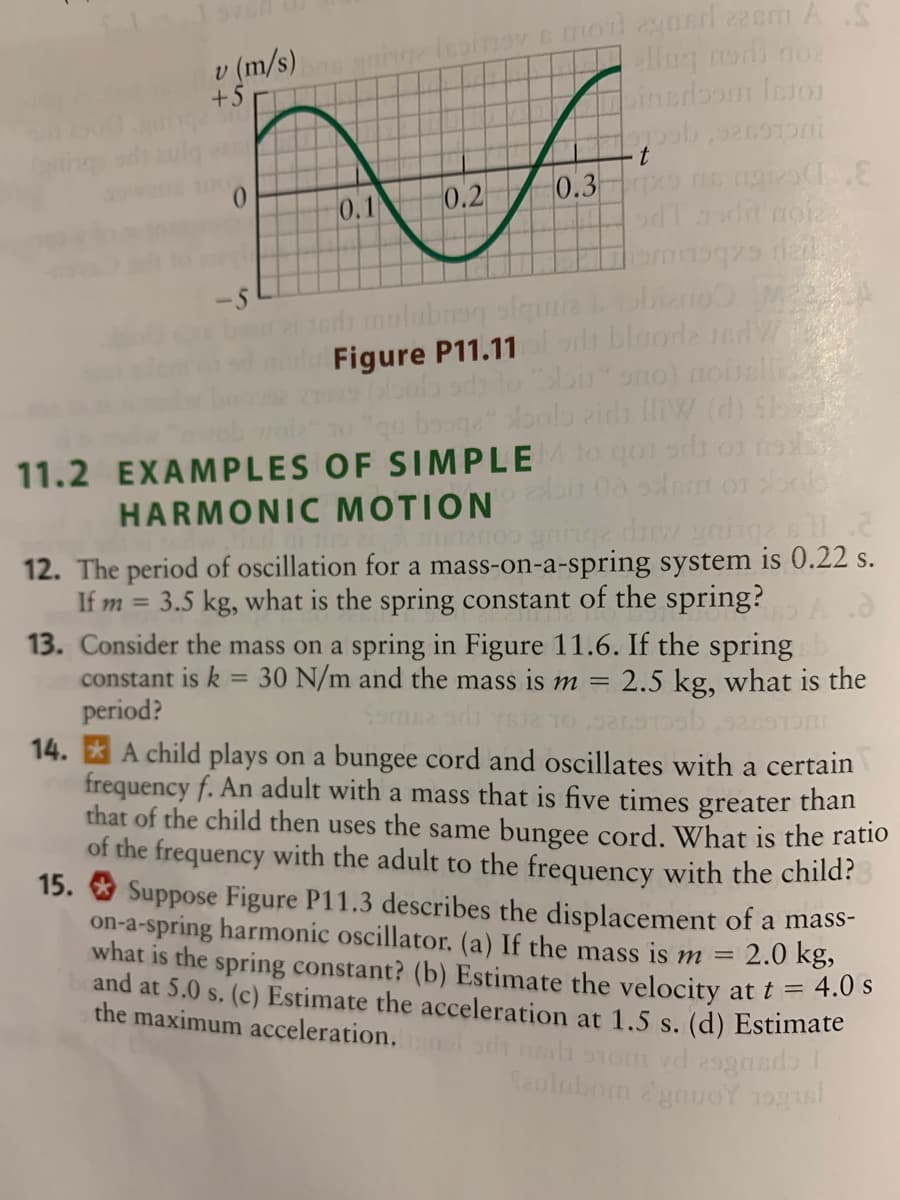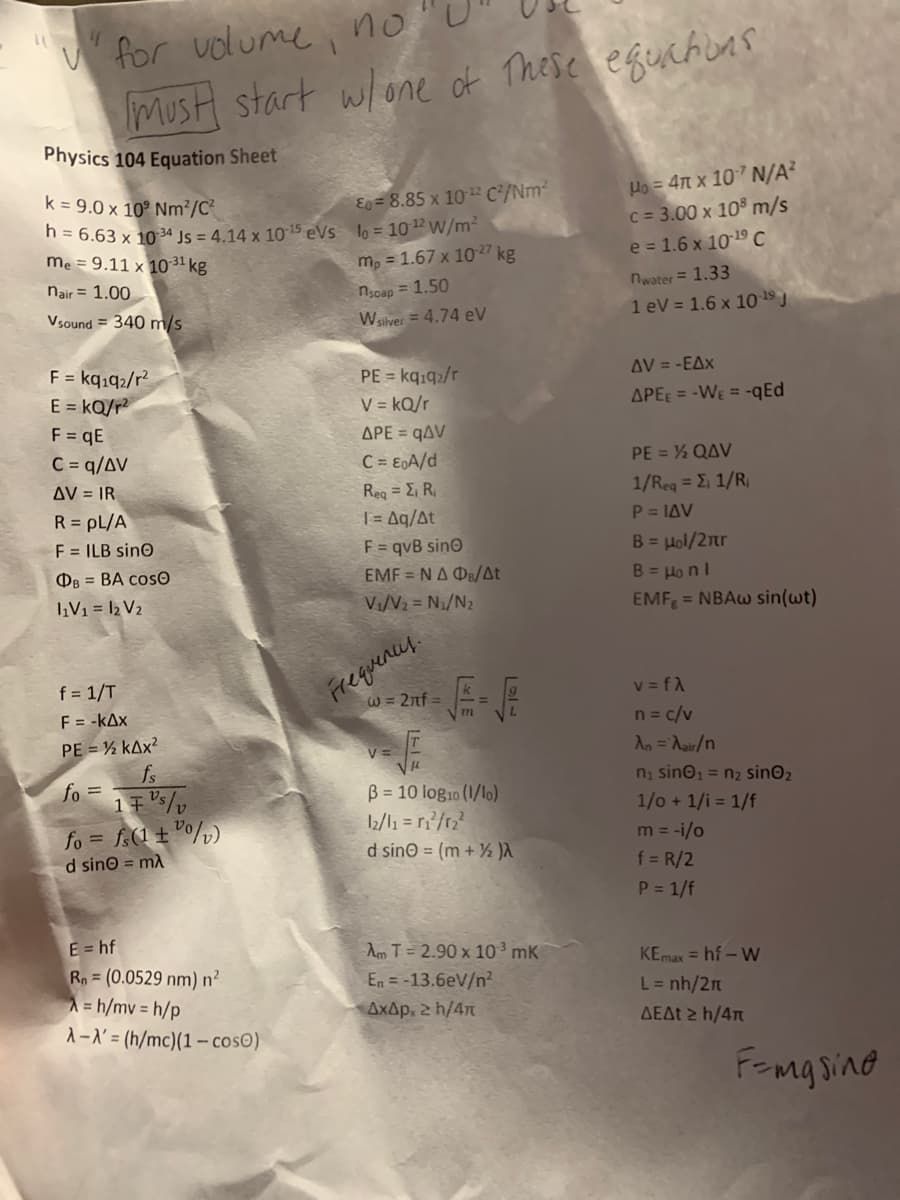14. * A child plays on a bungee cord and oscillates with a certain frequency f. An adult with a mass that is five times greater that of the child then uses the same bungee cord. What is the ratio of the frequency with the adult to the frequency with the child? 15. * Suppose Figure P11.3 descrihes the dionl than
14. * A child plays on a bungee cord and oscillates with a certain frequency f. An adult with a mass that is five times greater that of the child then uses the same bungee cord. What is the ratio of the frequency with the adult to the frequency with the child? 15. * Suppose Figure P11.3 descrihes the dionl than
Physics for Scientists and Engineers: Foundations and Connections
1st Edition
ISBN:9781133939146
Author:Katz, Debora M.
Publisher:Katz, Debora M.
Chapter15: Fluids
Section: Chapter Questions
Problem 1PQ
Related questions
Question
Problem 14. The last person did the wrong problem. Please show formula from equation sheet.

Transcribed Image Text:ng leoinov c mol gasd zeem A
llug nedi no
v (m/s)
+5
pinsdbom Inion
inge
0.
0.2
0.3
0.1
edh mulubreq olgmie obinoM
Figure P11.11lodt blooda ndV
-5
bu ono) noillic
qu bouga Aonlo zida HiW (d) Sh
11.2 EXAMPLES OF SIMPLE ogo odi o o
HARMONIC MOTION
12. The period of oscillation for a mass-on-a-spring system is 0.22 s.
If m
3.5 kg, what is the spring constant of the spring?
13. Consider the mass on a spring in Figure 11.6. If the spring
constant is k = 30 N/m and the mass is m =
period?
14. * A child plays on a bungee cord and oscillates with a certain
frequency f. An adult with a mass that is five times greater than
that of the child then uses the same bungee cord. What is the ratio
of the frequency with the adult to the frequency with the child?
15. O Suppose Figure P11.3 describes the displacement of a mass-
on-a-spring harmonic oscillator. (a) If the mass is m
what is the spring constant? (b) Estimate the velocity
and at 5.0 s. (c) Estimate the acceleration at 1.5 s. (d) Estimate
the maximum acceleration.
%3D
2.5 kg, what is the
2.0 kg,
at t = 4.0 s
ah nh onom vd 29gasdo
Seulubom gouOY 10gs

Transcribed Image Text:" for uolume i no
MusH start wlone of These egechuns
Physics 104 Equation Sheet
k = 9.0 x 10° Nm?/C?
h = 6.63 x 10 34 Js = 4.14 x 10 15 eVs lo = 10 W/m²
me = 9.11 x 10 31 kg
Ho = 4n x 10 N/A?
C = 3.00 x 10 m/s
e = 1.6 x 1019 C
E = 8.85 x 102 C/Nm2
m, = 1.67 x 1027 kg
nair = 1.00
nwater = 1.33
nsoap = 1.50
Vsound = 340 m/s
Wsilver = 4.74 eV
1 eV = 1.6 x 10 1º J
F = kqıq2/r?
E = kQ/r?
F = qE
C = q/AV
PE = kq.92/r
V = kQ/r
APE = qAV
C = E0A/d
AV = -EAx
APEE = -WE = -qEd
PE = % QAV
AV = IR
1/Rea = E, 1/R,
P = IAV
Reg = E, R,
| = Aq/At
F = qvB sino
EMF = NA Ds/At
R = pL/A
F = ILB sinO
B = Hol/2nr
B = Ho nl
EMF = NBAW sin(wt)
OB = BA cosO
įV1 = 12 V2
Vi/V2 = N1/N2
Frequences.
W = 2nf =
f = 1/T
v = fA
F = -kAx
n= c/v
PE = % kAx?
V=
An =Aair/n
fs
fo =
ni sino1 = n2 sinO2
B = 10 log10 (1/lo)
12/l1 = r/r;?
d sino = (m + ½ )a
1/o + 1/i = 1/f
fo = f(1 ± °°/)
m = -i/o
d sino = mA
f = R/2
P = 1/f
E = hf
Rn = (0.0529 nm) n²
A = h/mv = h/p
A-X' = (h/mc)(1 – cosO)
Am T = 2.90 x 10 mK
En = -13.6eV/n?
AxAp, 2 h/4
KEmax = hf - W
L= nh/2n
ΔΕΔ h /4π
FEmg sine
Expert Solution
This question has been solved!
Explore an expertly crafted, step-by-step solution for a thorough understanding of key concepts.
This is a popular solution!
Trending now
This is a popular solution!
Step by step
Solved in 2 steps with 2 images

Knowledge Booster
Learn more about
Need a deep-dive on the concept behind this application? Look no further. Learn more about this topic, physics and related others by exploring similar questions and additional content below.Recommended textbooks for you

Physics for Scientists and Engineers: Foundations…
Physics
ISBN:
9781133939146
Author:
Katz, Debora M.
Publisher:
Cengage Learning

University Physics Volume 1
Physics
ISBN:
9781938168277
Author:
William Moebs, Samuel J. Ling, Jeff Sanny
Publisher:
OpenStax - Rice University

An Introduction to Physical Science
Physics
ISBN:
9781305079137
Author:
James Shipman, Jerry D. Wilson, Charles A. Higgins, Omar Torres
Publisher:
Cengage Learning

Physics for Scientists and Engineers: Foundations…
Physics
ISBN:
9781133939146
Author:
Katz, Debora M.
Publisher:
Cengage Learning

University Physics Volume 1
Physics
ISBN:
9781938168277
Author:
William Moebs, Samuel J. Ling, Jeff Sanny
Publisher:
OpenStax - Rice University

An Introduction to Physical Science
Physics
ISBN:
9781305079137
Author:
James Shipman, Jerry D. Wilson, Charles A. Higgins, Omar Torres
Publisher:
Cengage Learning

Physics for Scientists and Engineers, Technology …
Physics
ISBN:
9781305116399
Author:
Raymond A. Serway, John W. Jewett
Publisher:
Cengage Learning